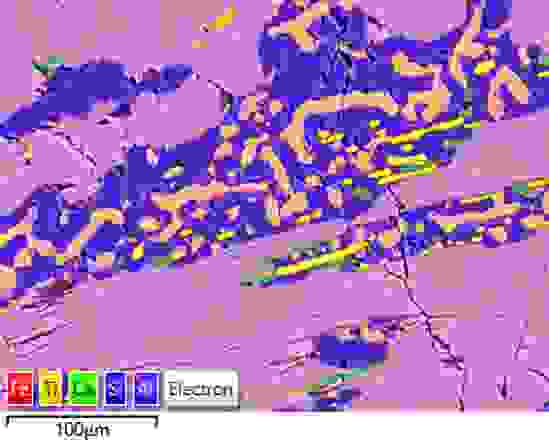Ever missed important compositional information using a backscattered electron detector? In this blog, I will introduce you to how backscattered electron and X-ray detection (BEX) is a game-changer when it comes to revealing cryptic features that don't stand out with regular backscattered electron (BSE) imaging. Unlike BSE, which reflects density contrasts in greyscale, the BEX detector delivers live X-ray data that helps pick up subtle elemental differences you’d otherwise overlook. To demonstrate this, we’re going to dive into a real-world example where BEX highlights significant exsolution features like never before. Ready to see what you could be missing?
Exsolution in minerals; what is it and why is it helpful?
In the world of geology, it’s always fascinating how much a rock can tell us about its history—if you know where to look. One of the key features geologists often study is exsolution lamellae, especially in minerals like pyroxene. Many common rock-forming minerals, such as pyroxene, exhibit what’s called solid solutions at high temperatures. At these elevated temperatures, large elements are incorporated more freely within the crystal lattice. But as these minerals cool, the lattice is less flexible, and immiscibility of the large elements can occur. This causes the formation of exsolution lamellae, where the large elements congregate to form an inclusion within the mineral (Figure 1). In pyroxene, for example, exsolution lamellae from potassium is kicked out of the crystal lattice at cooler conditions. Studying these exsolution features offers valuable clues about the cooling and deformation history of rocks, helping us to better understand their formation.

Figure 1: BEX Image highlighting the varied composition of exsolution features within a geological sample.
Challenges with identifying exsolution
One of the biggest challenges when analysing exsolution lamellae in pyroxene is getting accurate crystallisation temperatures. To do this, we need to reliably determine what the original, homogenised composition of the mineral was before exsolution took place. The tricky part? Exsolution lamellae can vary widely within just a single crystal. That means identifying and characterising multiple lamellae compositions—ranging from Fe-Ti oxides and orthopyroxene to amphibole, micas and different clinopyroxene subtypes—becomes essential. On top of that, these lamellae can occur on scales anywhere from micrometres to millimetres, making high spatial resolution important to find them in the first place.
The traditional search for exsolution features starts with light microscopy and BSE imaging to identify areas of interest. Once that’s done, targeted energy-dispersive spectroscopy (EDS) or electron probe microanalysis (EPMA) can be used for quantification of the exsolution features composition. But here’s the problem; lamellae that are either too small or lack significant BSE contrast can easily slip under the radar during these fast and large area searches, going undetected altogether. This is where the Unity BEX imaging detector shines—its ability to provide rapid X-ray information can uncover these cryptic features that BSE imaging might miss entirely.
A fresh look, using BEX to reveal undetected exsolution
Whilst performing demonstrations of the Unity detector at a conference, we investigated a pyroxene-bearing gabbronorite casually brought along by an attendee. Previous analyses using BSE imaging and EPMA mapping revealed Fe-rich, Na-rich, and Ti-rich lamellae that had significant BSE contrast (Figure 2a). But when we applied the BEX technique, cryptic Al-K-rich lamellae were revealed—something BSE had completely missed (Figure 2b).

Figure 2: BEX image reveals cryptic K-Al bearing exsolution with no clear greyscale contrast in BSE.
The provider of the sample, Dr. Anwesha Banerjee of IIT Mumbai, explains, "Rapid compositional analyses would enable quick characterisation of the pyroxene exsolution features. The most significant contribution of this technique has been the ability to resolve the halo of Al-rich phase around the Fe-rich exsolution." She further notes, "The X-ray elemental maps generated through EPMA did not enunciate this variation, leading us to assume there was an exsolution of only two end member compositions."
This discovery could have significant implications for how we understand the cooling history of this rock. The original homogenised composition of the pyroxene could have been quite different from what was used in past thermometry calculations, given the newly identified presence of aluminium. Furthermore, the separated exsolution of Fe, followed by Al and K, could be linked to the sizes of the cations, hinting at an extended period of diffusion during cooling or deformation.
Summary and wider implications
The Unity BEX imaging detector has demonstrable advantages over traditional BSE imaging workflows. By uncovering cryptic features that traditional BSE imaging lacks the ability to identify, BEX gives us a rapid reassessment of the chemical diversity within pyroxene and a fresh look at its cooling history.
Importantly, this benefit extends far beyond the reaches of geology. Other users have found great advantages for discovering contaminants in additive manufacturing (AM) powders and finding specific steel types within metallic aerospace debris. It’s not just about seeing more - it’s about investigating your samples in a quick, informative and intuitive manor. Why settle for less when you can have the full picture?



